Contact us

- 01 / 联系方式
欧马腾会展科技(上海)有限公司
 咨询热线:400-6179-888
咨询热线:400-6179-888

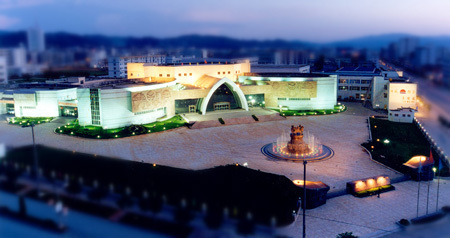
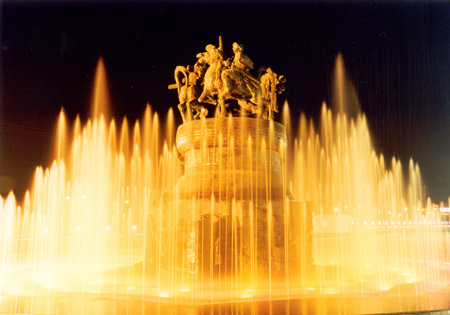
玉溪市博物馆
Yuxi Museum
中国 国家级综合类博物馆。位于云南省玉溪市红塔大道30号。1999年被云南省委、省政府确定为“云南省爱国主义教育基地”,2000年被云南省人民政府确定为“云南省科学普及教育基地”,2009年被国家文物局评定为“国家二级博物馆”,2012年被云南省委、省政府评为“云南省文明单位”, 2013年被云南省社会科学联合会列为“云南省社会科学普及示范基地”, 2014年被全国社会科学普及工作经验交流会组委会列为“全国人文社会科学普及基地”,2015年被中国科学技术协会确定为“全国科普教育基地”。
沿革 玉溪市博物馆(主体馆)成立于1997年4月,2000年建成对外开放,聂耳纪念馆(附属馆)2008年6月成立,2009年5月对外开放。是展示玉溪自然及人文历史、突出本地文化特色的综合类博物馆,也是市内标志性文化建筑。占地面积40亩,建筑面积12096平方米。主体建筑造型新颖、寓意独特。馆区环境整洁优美,场馆设施功能齐全。
藏品 本馆藏品22806件,以玉溪古生物化石及历史文物为主。其中,古生物化石包括“世界自然遗产——澄江寒武纪古生物化石”和中生代恐龙化石,历史文物有玉溪窑青花瓷、云南青铜器、聂耳文物、革命文物等。
展览 主体馆有七个主题常设展览和二个临时展厅。七个常设展是:“生命圣地——古生物展”、“先民足迹——玉溪史前文化展”、“翰墨流芳——书画艺术展”、“技艺传承——玉溪非物质文化展”、“烽火硝烟——滇中革命斗争史展”、“文明之光——玉溪青铜文化展”、“土火之艺——玉溪陶瓷展”。 附属馆聂耳纪念馆位于玉溪市聂耳文化广场,面积4000平方米,由一、二楼的基本陈列厅和三楼的大型半景画厅构成,陈列分为“匆匆却又永恒”、“永久的纪念”、“国歌的诞生”三个部份。以史料、照片、实物等文物,展示了“人民的音乐家”聂耳的一生。
除开放常规展览之外,每年自办和引进各类临时展览。“穿越古滇文明之光——云南玉溪文物精品展”和“中国的声音——聂耳与国歌展”是本馆对外交流的两个展览项目。
学术研究 本馆重视学术研讨和出版推广工作。编撰出版《云南玉溪窑》、《云南华宁陶》两部陶瓷专集,2013年起创办馆刊《玉溪博物与收藏》半年刊,已经连续出版多期,受到同行及读者欢迎。
As a cultural landmark building founded in 1997, Yuxu Museum is comprehensive museum integrating collection, exhibition, scientific research, publicity and exchange. This museum, whose main buildings show unique connotation in novel style, covers land area of 40 Mus, and building area of 12,096 square meters. The museum area boasts clean and beautiful environment. Equipped with fully-functional facilities, the venue consists of various areas, such as for display, administrative office, collection warehouse, comprehensive service, business and scientific research, garden-type ecological greening, and visitors’ leisure and evacuation.
Furnished with over 10,000 collections, this museum provides seven thematic standing exhibitions. By dint of novel display concepts and modern acousto-optic and electrical technologies, they present uniquely-designed and elaborately-made collections, with the support of various forms, such as sculpture, touch screen, film & TV, simulation scene, and interaction with audience. On this basis, they display Yuxi’s natural and humanistic historical look in an all-round manner, deeply explore local humanistic resources, and highlight local cultural characteristics. As a result of this, arrays of high-quality and fascinating collections are display to the public.
Paleontological exhibition (1st and 2nd floor)
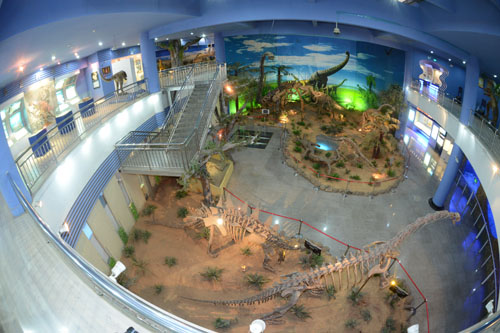
Equipped with abundant fossil remains, Yuxi truly recodes the information of ancient creations. In Mount Maotian, Chengjiang, there are the fauna fossils hailed as one of the most shocking scientific discoveries in the 20th century, which has revealed a most important stage of terrestrial life history—the truth of Cambrian Explosion. In the counties such as Yimen, E’shan, Huaning, Chengjiang, and Jiangchuan, there are quantities of dinosaur fossils, which prove that Yuxi is the habitation of early dinosaurs. Here, people can either enjoy the astonishing development history of Cambrian life 530 million years ago, or witness the process in which the dinosaurs, known as Mesozoic dominator, developed from prosperity to extinction.
Chengjiang orictocoenosis is discovered to consist of 16 phylums, over 200 species, including 146 new genera, and 162 new species. They include the Yunnanozoon—the earliest ancestor of vertebrate, Fuxianhuia— the earliest ancestor of insect, and anomalocaris-the Cambrian sea king with the body length of 2 meters.
On July 1, 2012, the 36th World Heritage Committee voted for listing Chengjiang orictocoenosis as World Natural Heritage. Chengjiang fossil locations separately became the 9th and the 33rd World Natural Heritage in China and Yunnan, thus filling in the blank of Chinese fossils in the field of World Cultural Heritage.
Yuxi boasts the precious dinosaur fossil specimen in the Late Triassic-Early Jurassic (200-180 million years ago), which belongs to Saurischia. They comprise yunnanosaurus magnus, yimenosaurus, lufengosaurus huenei young, coelurosaur, eshanosaurus(therizinosaurus), ect.
The discovery of dinosaur fossil is of great significance for the study on paleogeography, palaeoclimate, and paleontology in Yuxi.
Prehistoric cultural exhibition
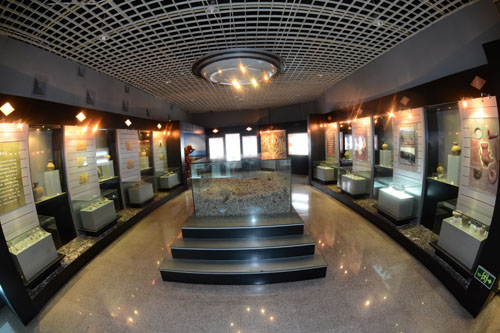
Archaeological discovery verifies that Yuxi is an early place where human appeared. About 1 million years ago, there were human beings who led a life in this fertile Middle Yunnan Plateau. This lengthy process developed from walking upright to boring wood to get fire, from forging tools to grinding tools, from fishing and hunting to farming, and from savage to civilization, thus creating the unique prehistoric culture.
It is discovered that Yuxi is now composed of two hominid sites in Palaeolithic Age, namely, Gantangqing, Luju Town, Jiangchuan County, and Laolongdong, Tadian Town, E’shan County. In these two sites, there are a large quantity of unearthed stone implements, bone implements, and zooliths. The site of Gangtanqing, Luju Town, Jiangchuan County was the early type of the Palaeolithic Age, which was 1 million years away from now. The site of Laolongdong, Tadian Town, E’shan County was the type of Late Pleistocene, which was10, 000-20,000 years away from now. It is the hominid cave site that is best preserved with the most abundant buried objects in Yunnan. The sites of the Palaeolithic Age cover the whole city. In particular, the regions of three lakes were the ideal environment for ancient human’s farming, fishing and hunting, living and reproduction. In these regions, a large number of stone implements, bone implements, and potteries have been unearthed successively. The stone implements comprise axe, adze, bracelet, ball, spinning wheel, board for making porcelain seal, etc; bone implements include axe, spade-shaped farm tool, awl, etc; and potteries consist of jar, pot, basin, bottle cup, etc.
Bronze culture exhibition
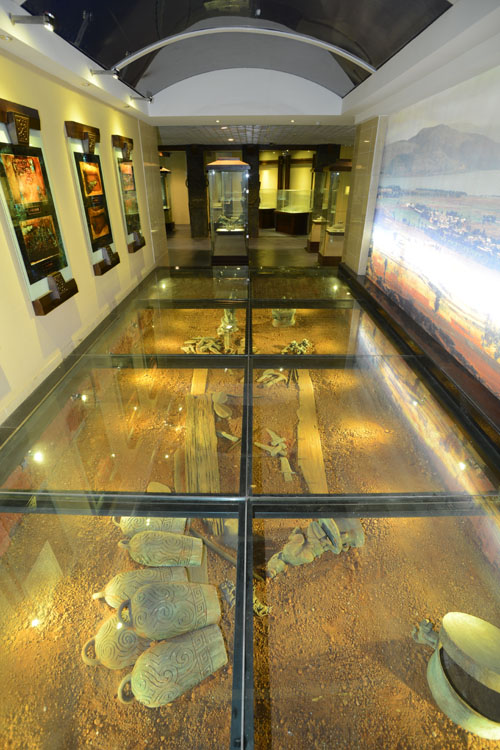
Yuxi was one of cradles for the cultures of ancient Yunan. Ancient Yunnan was a mysterious ancient country which flourished around the Dianchi Lake, and the three lakes of Yuxi from the Warring States Period to the Western Han Dynasty. However, after 300-400 years of prosperity, ancient Yunnan vanished in silence, which has caused the endless guesses and imaginations of the later generations.
According to the archaeological discovery, bronze relics unearthed from ancient tombs of Mount Lijian in Jiangchuan County include a large number of complicated and exquisitely-made categories , which not only re-display the styles and features of ancient Yunnan, such as about economy, society, military, culture, religion and art, but also witness the birth, development and vanishing of ancient Yunnan.
History for revolutionary struggle of central Yunnan Province
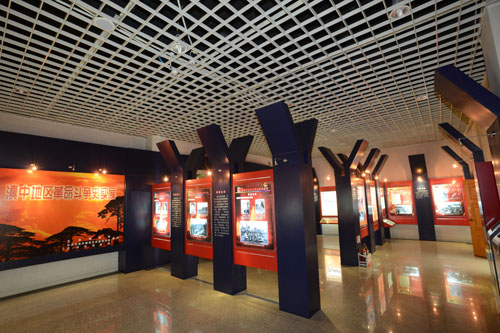
In 1927, the Chinese Communist Party was involved in democratic revolutionary struggle in central Yunnan Province. During the following 20 years, the Party has been like a kindling, inspiring the enthusiasm of all ethnic groups in central Yunnan Province in overturning the reactionary rule of imperialism, feudalism, and bureaucrat capitalism. Additionally, it has rapidly developed into the raging flames of burning the old world to liberate all ethnic groups in this region. At that period, all people from Yuxi, either male or female, have made commendable struggle achievements in a bitter and tough context, thus forging an immortal historical monument in central Yunan Province.
Porcelain exhibition
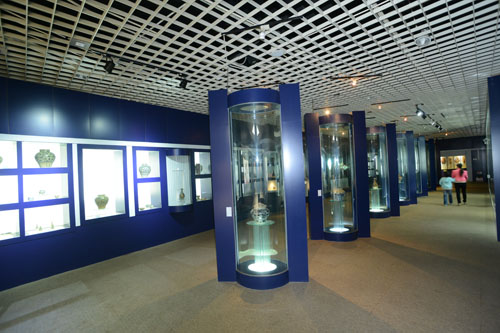
In addition to Jingdezhen Kiln, Yuxi Kiln, one of the important kiln sites for firing blue-and-white porcelains in China’s Ming Dynasty
This Kiln was mainly used to fire celadon-glazed blue-and-white porcelains and celadon-glazed printed (engraved) porcelains, such as jar, plate, bowl, cup, stove, and bottle. The products were made of local porcelain clay and cobalt, and fired by dint of advanced techniques at that time. The production workmanship and pattern show that these products have robust styles, vivid and simple patterns, deep white and blue colours and free-and-easy painting techniques, besides striking ethnic folk characteristics.
The discovery and excavation of Yuxi Kiln have clearly manifested the production and development status of blue-and-white porcelains. Exerting a wide influence in the world, this site played an important role either in Chinese porcelain or in fine art histories. Its unearth relics have ever been exhibited in the regions such as UK, JK and Japan.
Painting and calligraphy exhibition
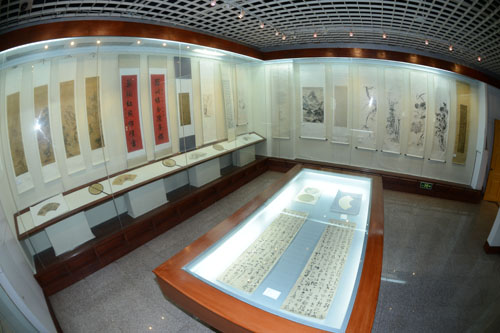
Chinese painting and calligraphy are the time-honoured traditional arts with unique styles. Yunan has made superior achievements in painting and calligraphy the Han and Tang Dynasties. In Ming and Qing Dynasties, the masters of painting and calligraphy came forth in large quantities, over 200 of who became notable inside and outside the provinces. In those periods, they have created numerous masterpieces, thus leaving behind previous cultural heritages for the descendents.
In Ming and Qing Dynasties, painting and calligraphy were prevalent, with various famous painters and calligraphers emerging, such as Kan Zhenzhao, Zhao Shilin, Ma Ruwei, Zhou Yuli, Zhong Yue, and Zhou Chuanjing. Due to the high artistic value, their works enjoyed a reputation among both the court and the commonalty, and even benefit contemporary generations. Additionally, these works have developed unique tradition of painting and calligraphy art, which has yielded arrays of fascinating achievements in either ancient or modern times.
Intangible cultural heritages exhibition
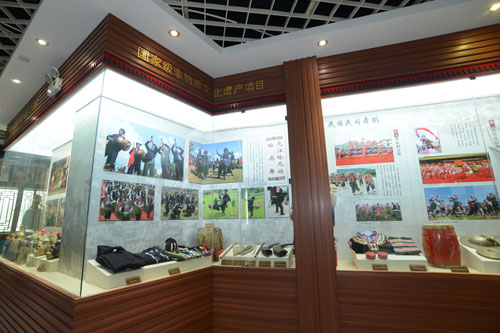
Intangible cultural heritage is the manifestation means of traditional cultures that exist in non-physical form, relate closely to people’s life and pass on from generation to generation, including traditional performance art, festival and folk etiquette, traditional folk craftsmanship. In Yuxi, there are 9 major ethnic groups inheriting their own traditional cultural heritages, which have penetrated into people’s daily life. All these ethnic groups have created and left behind precious historical cultural heritages as well as colourful intangible cultural heritages.
Nie’er Memorial

Located in Yuxi Nie’er Culture Square with an area of 4000 square meters, Nie’er Memorial is the branch of Yuxi Museum, which displays the short but brilliant life of “Nie’er – People’s musician” through detailed historical data, photos and real objects.
原文来源于www.omaten.com
 欧马腾获“中国十佳品牌会展服务商”、“中国会展行业杰出人物奖”殊荣
欧马腾获“中国十佳品牌会展服务商”、“中国会展行业杰出人物奖”殊荣 欧马腾·2024CMEF中国国际医疗器械博览会答谢晚宴圆满落幕!
欧马腾·2024CMEF中国国际医疗器械博览会答谢晚宴圆满落幕! 从容启程,骉马同行!欧马腾2月18日开工大吉
从容启程,骉马同行!欧马腾2月18日开工大吉 驫马奔腾,驭势同行|2023年欧马腾年终盛典圆满落幕
驫马奔腾,驭势同行|2023年欧马腾年终盛典圆满落幕 欧马腾集团2023年股东大会圆满召开!
欧马腾集团2023年股东大会圆满召开! 欧马腾CEO师欣欣受邀出席上海市青年联合会第十三届委员会第一次会议
欧马腾CEO师欣欣受邀出席上海市青年联合会第十三届委员会第一次会议版权所有 欧马腾会展科技(上海)有限公司 沪ICP备14041070号 网站地图xml
Copyright © 2019 omaten.com Inc. All Rights Reserved.

友情链接